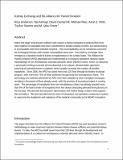Kidney Exchange and the Alliance for Paired Donation: Operations Research Changes the Way Kidneys Are Transplanted
Author(s)
Rees, Michael; Roth, Alvin E.; Sönmez, Tayfun; Ünver, M. Utku; Anderson, Ross Michael; Ashlagi, Itai; Gamarnik, David; ... Show more Show less
DownloadKidney-Exchange-David-Gamarnik.pdf (617.9Kb)
OPEN_ACCESS_POLICY
Open Access Policy
Creative Commons Attribution-Noncommercial-Share Alike
Terms of use
Metadata
Show full item recordAbstract
Many end-stage renal disease sufferers who require a kidney transplant to prolong their lives have a relative or friend who has volunteered to donate a kidney to them, but whose kidney is incompatible with the intended recipient. This incompatibility can sometimes be overcome by exchanging a kidney with another incompatible patient-donor pair. Such kidney exchanges have emerged as a standard mode of kidney transplantation in the United States. The Alliance for Paired Donation (APD) developed and implemented nonsimultaneous extended altruistic donor (NEAD) chains, an innovative technique that allows a previously binding constraint (of simultaneity) to be relaxed; thus, it permits longer chains and better-optimized matching of potential donors to patients, greatly increasing the number of possible transplants. Since 2006, the APD has saved more than 220 lives through its kidney exchange program, with more than 75 percent of these achieved through nonsimultaneous chains. Other kidney exchange programs have adopted the technology and methods pioneered by APD, resulting in more than 1,000 lives already saved, with the promise of increasing impact in coming years. In 2013, the percentage of transplants from nonsimultaneous chains reached more than six percent of the number of transplants from living donors. In this paper, we describe the long-term optimization and market design research that supports this innovation. We also describe how a team of physicians and operations researchers worked to overcome the skepticism and resistance of the medical community to the NEAD innovation.
Date issued
2015-02Department
Sloan School of ManagementJournal
Interfaces
Publisher
Institute for Operations Research and the Management Sciences (INFORMS)
Citation
Anderson, Ross et al. “Kidney Exchange and the Alliance for Paired Donation: Operations Research Changes the Way Kidneys Are Transplanted.” Interfaces 45, 1 (February 2015): 26–42 © 2015 Institute for Operations Research and the Management Sciences (INFORMS)
Version: Author's final manuscript
ISSN
0092-2102
1526-551X